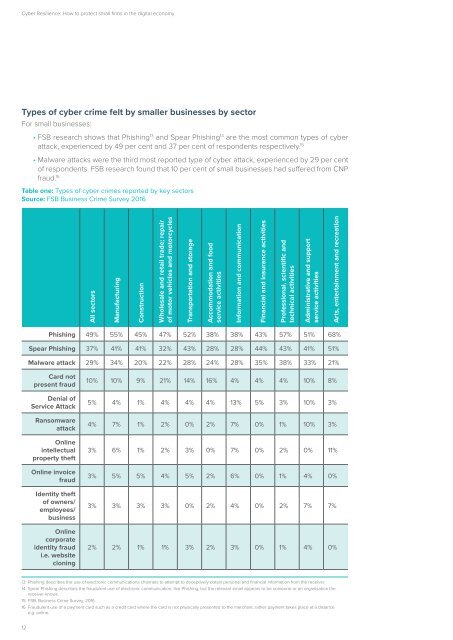CYBER RESILIENCE HOW TO PROTECT SMALL FIRMS IN THE DIGITAL ECONOMY
FSB-Cyber-Resilience-report-2016
FSB-Cyber-Resilience-report-2016
Create successful ePaper yourself
Turn your PDF publications into a flip-book with our unique Google optimized e-Paper software.
Cyber Resilience: How to protect small firms in the digital economy<br />
Types of cyber crime felt by smaller businesses by sector<br />
For small businesses:<br />
• FSB research shows that Phishing 13 and Spear Phishing 14 are the most common types of cyber<br />
attack, experienced by 49 per cent and 37 per cent of respondents respectively. 15<br />
• Malware attacks were the third most reported type of cyber attack, experienced by 29 per cent<br />
of respondents. FSB research found that 10 per cent of small businesses had suffered from CNP<br />
fraud. 16<br />
Table one: Types of cyber crimes reported by key sectors<br />
Source: FSB Business Crime Survey 2016<br />
All sectors<br />
Manufacturing<br />
Construction<br />
Wholesale and retail trade; repair<br />
of motor vehicles and motorcycles<br />
Transportation and storage<br />
Accommodation and food<br />
service activities<br />
Information and communication<br />
Financial and insurance activities<br />
Professional, scientific and<br />
technical activities<br />
Administrative and support<br />
service activities<br />
Arts, entertainment and recreation<br />
Phishing 49% 55% 45% 47% 52% 38% 38% 43% 57% 51% 68%<br />
Spear Phishing 37% 41% 41% 32% 43% 28% 28% 44% 43% 41% 51%<br />
Malware attack 29% 34% 20% 22% 28% 24% 28% 35% 38% 33% 21%<br />
Card not<br />
present fraud<br />
Denial of<br />
Service Attack<br />
Ransomware<br />
attack<br />
Online<br />
intellectual<br />
property theft<br />
Online invoice<br />
fraud<br />
Identity theft<br />
of owners/<br />
employees/<br />
business<br />
Online<br />
corporate<br />
identity fraud<br />
i.e. website<br />
cloning<br />
10% 10% 9% 21% 14% 16% 4% 4% 4% 10% 8%<br />
5% 4% 1% 4% 4% 4% 13% 5% 3% 10% 3%<br />
4% 7% 1% 2% 0% 2% 7% 0% 1% 10% 3%<br />
3% 6% 1% 2% 3% 0% 7% 0% 2% 0% 11%<br />
3% 5% 5% 4% 5% 2% 6% 0% 1% 4% 0%<br />
3% 3% 3% 3% 0% 2% 4% 0% 2% 7% 7%<br />
2% 2% 1% 1% 3% 2% 3% 0% 1% 4% 0%<br />
13 Phishing describes the use of electronic communications channels to attempt to deceptively obtain personal and financial information from the receiver.<br />
14 Spear Phishing describes the fraudulent use of electronic communication, like Phishing, but the relevant email appears to be someone or an organisation the<br />
receiver knows.<br />
15 FSB, Business Crime Survey, 2016.<br />
16 Fraudulent use of a payment card such as a credit card where the card is not physically presented to the merchant, rather payment takes place at a distance<br />
e.g. online.<br />
12


